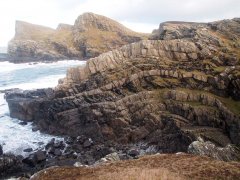A Guide to the Geology of Islay. An introduction to Islay’s geological past with 12 illustrative excursions
David Webster, Roger Anderton and Alasdair Skelton
(David Webster and Roger Anderton are both members of the society.)
The guide describes 12 varied excursions on Islay that tell the story of Islay’s geological past from 2 billion year old gneiss to the Ice Age. The geology of each excursion is described at an introductory level with geological maps and photographs and for novices the book also contains an "Introduction to Geology" section and a glossary of terms.
For those with a geological background there is a section describing Islay’s geological framework in more detail with some key references for further reading.
The excursions range from leisurely rambles to more demanding longer walks, most of which are readily adaptable with shorter easier options.
At the end of each excursion itinerary, there is a suggestion for a local whisky to finish the day off. (There are currently eight active distilleries on Islay.)
The following extract from the book's preface indicates why the geology of Islay is so interesting:
-
The Islay area is the best place in the British Isles to see the 1,800 Ma metamorphic rocks (the Rhinns Complex). This small outcrop may be part of a more extensive mass which underlies much of central Scotland.
-
Relatively undeformed deltaic and submarine fan deposits of the Colonsay Group (now believed to be part of the Dalradian Grampian Group) in contact with Rhinnean basement.
-
A classic passive margin sequence (the Appin and Argyll Groups of the Dalradian) Now inverted but with relatively low-grade metamorphism resulting in the excellent preservation of the original depositional features.
-
The best evidence in the British Isles of Precambrian life in the form of microbial stromatolites.
-
The world-famous Port Askaig Tillite which is probably representative of a global glaciation at 635 Ma (equivalent of the Marinoan), with an overlying possible (but atypical) cap-carbonate sequence (the Bonahaven Dolomite).
-
Good examples of the re-activation and reversal of syn-depositional extensional faults.
-
A good place to study mineralisation and fluid-flow: at least three distinct episodes can be observed ranging from metamorphic fluid flow resulting in carbonation of metabasite sill margins during the Caledonian Orogeny, late Carboniferous sulphide mineralisation and Permo-Triassic brecciation and dolomitisation.
-
A variety of Cenozoic-age igneous intrusions related to the opening of the North Atlantic.
-
A wide variety of Ice Age erosional and depositional features, including spectacular raised platforms, eskers, fluviatile outwash deposits and cryoturbation.

Folded metasandstones of the Smaull Greywacke Formation with Dun Bheolain ("The Opera House Rocks") in the background (photo: D. Webster). This is one of the many photographs in the guide.
The guide is published by Ringwood Publishing. It can be viewed and purchased at the society's bookshop, which is open after the monthly lectures. If you cannot manage to the lectures, or would like to purchase a copy before the next meeting, you can do so by using the society's customised Amazon bookshop.